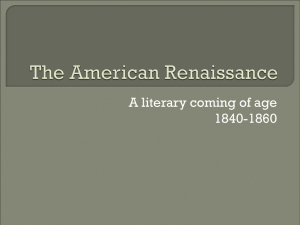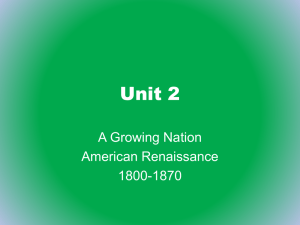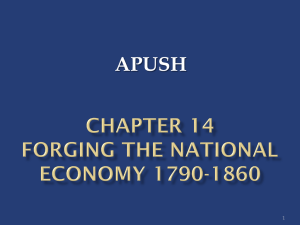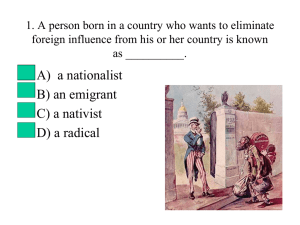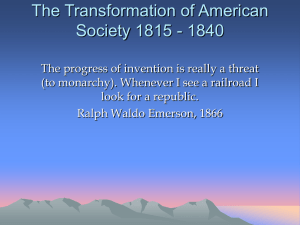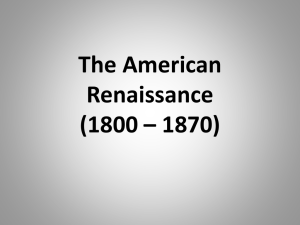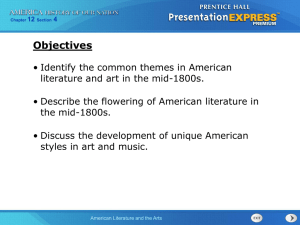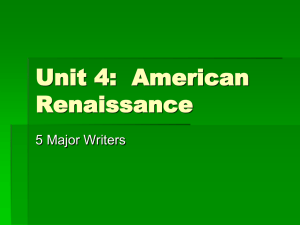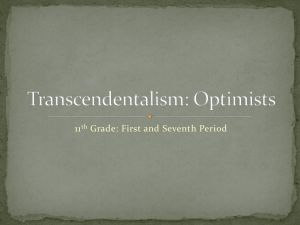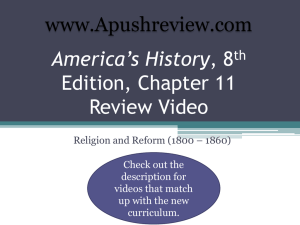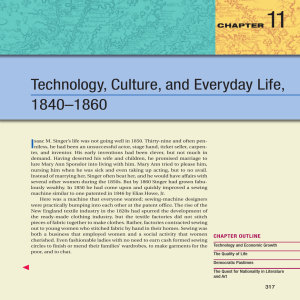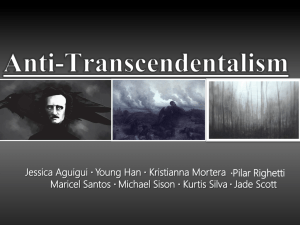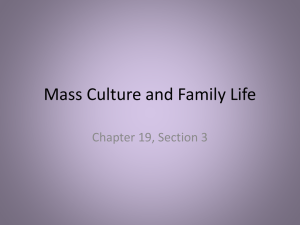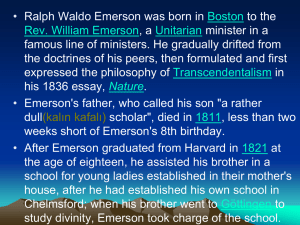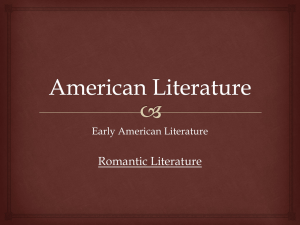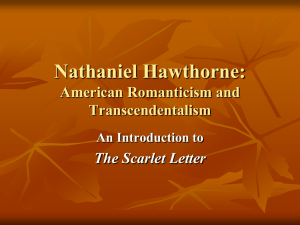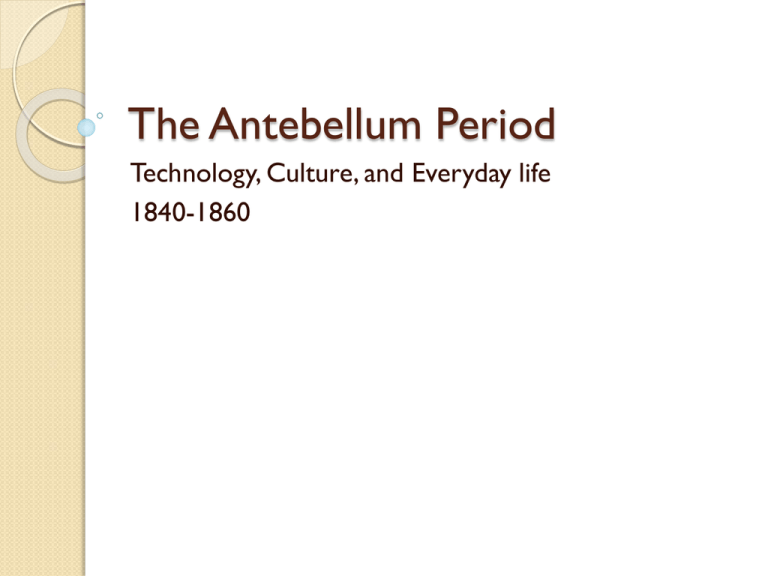
The Antebellum Period
Technology, Culture, and Everyday life
1840-1860
Introduction
In the 1840’s and 1850’s, most Americans
believed God had ordained that man should
progress (morally and materially)
• The means to progress of both kinds was
through technology
•
– Americans defined as “the application of science to
improve the conveniences of life”
We will look at the changes in the everyday life
of ordinary citizens brought about by the new
technology of the period of 1840-1860
• Also looking at the ways people responded to
those transformations
•
Introduction (cont.)
1.) How did technology transform the daily lives
of middle-class Americans between 1840 and
1860?
2.) How did American pastimes and
entertainment change between 1840 and 1860?
3.) How did Americans express their
distinctiveness in their literature and art?
Technology and Economic Growth
Introduction
◦ Pre-Civil War decades were affected and transformed
American life by:
The steam engine
Cotton gin
Reaper
Sewing machine
Telegraph
◦ This new technology increase productivity and eased
travel and communication
◦ Also it brought down costs and prices
Introduction (cont.)
Most Americans between 1840 and 1860
enjoyed improved standards of living
But the new technology hurt other Americans
◦ The cotton gin encouraged the expansion of the
plantation-slave economy
◦ Sewing machines and new manufacturing techniques
rendered traditional crafts and the artisans who
practiced them obsolete
Agricultural Advancement
Between 1830 and 1860,
settlers moved onto the
grasslands of IN, MI, and
IL
John Deer’s steel-tipped
plow was developed in
1837
Used to break up the
tough prairie soil
Agricultural Advancement (cont.)
Cyrus McCormick
◦ 1847
◦ Massed produced
mechanical reapers
◦ Farmers could harvest grain
7 times faster than before
and use 1/2 the labor
Wheat became the
dominate crop of the
Midwest
Agricultural Advancement
(cont.)
Americans quickly adopted these laborsaving
inventions
But they generally farmed wastefully
◦ Rapidly depleted the soil
◦ Then moved on to virgin land
In the East some farmers introduced fertilizers
◦ Increased their yields so they could compete with the
new western fields
In the South farmers had little incentive to
invest in laborsaving machinery (used slaves)
Technology and Industrial
Progress
Americans of the
antebellum period readily
invested in new
technology
Eli Whitney
◦ Interchangeable parts
◦ Greatly facilitated by
improved machine tools
Europeans called
interchangeable parts
“American System of
Manufacturing
Technology and Industrial
Progress (cont.)
Readiness to invest in innovations,
interchangeable parts, and better machine tools
Resulted in:
◦ Rapid acceptance
◦ Mass production
◦ Use of the new inventions
Samuel Colt’s revolving pistol
Elias Howe’s sewing machine
Samuel F. B. Morse’s telegraph
The Railroad Boom
By 1860, the United States had 30,000
miles of track
◦ More than the rest of the world combined.
Most of the new rail lines linked the East
and Midwest.
Much of the produce of the Midwest was
now shipped via railroads radiating from
Chicago eastward.
The Railroad Boom (cont.)
Positives of the railroad growth:
◦ simulated the settlement of the Midwest
◦ Growth of wheat farming
◦ Aided the development of cities, towns, and industry
Several states barred funding of the railroads
◦ Encouraged a shift toward private investment
The Railroad Boom (cont.)
Railroad was America’s 1st big business
Railroads pioneered new forms of
financing in the 1850’s
◦ Sale of stock and other securities
◦ Many of the transactions were handled
through Wall Street
◦ Made NY the nation’s leading capital market
Rising Prosperity
Technological improvements reduced the price
of commodities to consumers
◦ Contributed to an average 25% rise in the real
income of American workers between 1840 and 1860
The increased annual income of working
families also was attributable to the use of
steam power
◦ Allowed factories to operate in all seasons
◦ Offer work to more laborers
Rising Prosperity (cont.)
The growth of towns and cities that
accompanied industrialization opened new
employment opportunities for women and
children
◦ Often had to work to supplement the inadequate
wages of the husband/father
There was a steady stream of American to cities
◦ economic opportunities plus the comforts and
conveniences of urban life
The Quality of Life
Introduction
◦ Technological advances improved the quality
of life in the middle class
Now enjoyed luxuries formerly reserved for the
rich
◦ These changes were slower to reach the poor
Increasingly came to congregate in cramped urban
tenements
Introduction (cont.)
Medical knowledge lagged behind the
strides made in industry and agriculture
◦ Many Americans looked to popular health fads
for the prevention and cure of illness
Dwellings
In the cities the typical
dwellings of the period
were row houses
Middle class row houses
became elaborate
Poor were forced into
crowded row houses that
were further subdivided
by several families and
boarders
Dwellings (cont.)
Log cabins
◦ On the frontier
◦ Often times 1 room
As the communities matured and
prospered
◦ Log cabins were replaced by more
comfortable houses
◦ Larger homes
Dwellings (cont.)
Upper class and middle
classes favored ornate
home furnishings in the
rococo style
rococo furniture
Wealthy imported
furniture from Europe
Middle class bought massproduced imitations from
new furniture
manufacturing centers
◦ Cincinnati
◦ Grand Rapids
Conveniences and
Inconveniences
Industrialization and improved affected home
heating, cooking, and diet
By 1840’s, coal-burning stoves were replacing
fireplaces for heating and cooking
◦ These stoves were more convenient
◦ Made it possible to cook several dishes at once
◦ Coal burning contributed to fouling the urban
environment
Conveniences and
Inconveniences (cont.)
Railroads brought fresh produce to city
dwellers
◦ Only the rich could afford fruits out of season
Home iceboxes were rare before 1860
◦ Most Americans still ate meat preserved by
salting rather than fresh meat
Ice Boxes
Conveniences and
Inconveniences (cont.)
By the 1840’s and 1850’s, cities such as New
York began to construct aqueducts, reservoirs,
and water works
◦ Brought pure water to street hydrants
The majority of houses were not yet hooked up
to the water main
◦ Americans of the time bathed infrequently
Few cities had sanitation departments
◦ Most people used outdoor privies (outhouses)
American cities often stunk
Disease and Health
Transportation boom increased and
widened the risks of epidemics
◦ Recurring epidemics of cholera, yellow fever,
and other diseases
The medical profession was held in low
esteem
◦ Divided and uncertain about the causes and
cures of epidemic diseases
Disease and Health (cont.)
Anesthetics were
developed in 1840’s
◦ Crawford Long
◦ William T.G. Morton
◦ Allowed advances in
the field of surgery
◦ Still failed to recognize
the importance of
disinfection
Popular Health Movements
Neither public-health boards nor doctors
seemed able to prevent disease
Many Americans put their faith in various
popular therapies
◦ Hydropathy
◦ Grahamite regimen
Phrenology
Most popular of the scientific fads of the
antebellum period
An accurate analysis of an individual’s character
Examining the contours of his skull
Promised to teach the principles of life
Give the individual control over his/her own
fate
Science was believed to be a tool to improve
ones life
Democratic Pastimes
Introduction
◦ New technology transformed leisure as well
as work between 1830-1860
◦ Imaginative entrepreneurs used new
inventions and advances in manufacturing to
sell the kinds of entertainment they believed
the public wanted
Newspapers
James Gordon Bennett
Publisher of New York
Herald
Used new techniques in
paper making and printing
Used the telegraph
Build a mass circulation
Newspapers (cont.)
Realized you could make $$$$ by building a
mass circulation
Slashed the price of the paper to a penny
Used newspaper boys to sell hundreds of
thousands of copies daily
The number of weekly papers grew from 65 to
138 (between 1830 and 1840)
Newspapers (cont.)
The penny papers filled their columns
with human-interest stories of crime and
sex
Bennett’s New York Herald and Horace
Greeley’s New York Tribune also pioneered
in modern financial and political reporting
The Theater
Antebellum theaters were filled with
large, rowdy audiences from all social
classes
People liked romantic melodramas best
William Shakespeare’s plays were
performed the most of any other
dramatist
Minstrel Shows
Minstrel shows=performances of songs, dances,
and skits by white men in blackface
Minstrel shows became popular in the 1840’s
with the white working-class audiences
Catered to and reinforced the prejudices of
whites
Depicted blacks as stupid, comical, musical, and
irresponsible
P.T. Barnum
Displays of curiosities
Flair for publicity
Development of the
American Museum in
New York
The ultimate
“entrepreneur of popular
entertainment” in the
antebellum era
The Quest for Nationality in
Literature and Art
Introduction
◦ Europeans in the early 19th
century looked down on
American writing
◦ Washington Irving
◦ Most successful American
writing in early 1800’s
“Rip Van Winkle”
“The Legend of Sleepy
Hollow”
Biography
Introduction (cont.)
“American Renaissance”
◦
◦
◦
◦
◦
After 1820
“a flowering of literature”
James Fenimore
Ralph Waldo Emerson
Walt Whitman
Some sought to develop a new, unique
American literature
Introduction (cont.)
The painters of the
Hudson River School
and Frederick Law
Olmsted in his
landscape design also
offered distinctively
American visions
Roots of the American
Renaissance
1820’s and 1830’s
2 things transformed the writing of fiction in
the U.S.A.
The transportation revolution
◦ Opened a nationwide market for books
Spread of the romantic movement
◦ Romanticism stressed feelings rather than learning
◦ Suited fiction well
Roots of the American
Renaissance (cont.)
Women still were not
admitted to most
colleges
Women could publish
best-selling romantic
novels
◦ Harriet Beecher
Stowe’s Uncle Tom’s
Cabin
Cooper, Emerson, Thoreau, Fuller
and Whitman
James Fenimore Cooper
The 1st of the “new”
writers
Introduced frontiersman
Natty Bumppo
◦ Particularly American
character
Cooper's works
Ralph Waldo Emerson
Wrote mostly essays
Transcendentalism
American brand of
romanticism
Emerson' works
Ralph Waldo Emerson (cont.)
Emerson rejected the importance of education
and reason in seeking the truth
He contented that every individual is capable of
knowing God, truth, and beauty by following his
feelings
Young, democratic America had nothing to learn
from Europe
◦ American could produce its own great literature and
art
Henry David Thoreau
Emerson’s disciple
Not only expressed his radical insights but lived
them
He went to jail rather than pay taxes to support
what he considered the “evil” Mexican War
He defended the right to defy unjust govt.
policies in his essay “Civil Disobedience” (1849)
Henry David Thoreau (cont.)
Thoreau's works
“he seems to have
wanted most to use
words to force his
readers to rethink
their own lives”
Margaret Fuller
Emerson discipline
Combined
transcendentalism and
feminism
Women in the
Nineteenth Century
(1845)
Walt Whitman
Leaves of Grass
Broke new ground in
poetry
◦ “lusty” and “bold”
◦ Free verse
◦ Celebrated the
American common man
Whitman's works
Hawthorne, Melville, and Poe
Nathaniel Hawthorne
The Scarlet Letter
Hawthorne works
Herman Melville
Moby Dick
Melville's works
Edgar Allen Poe
Poe's works
Poems and short
stories
The Raven
Hawthorne, Melville, and Poe
(cont.)
They were more interesting in writing in
analyzing moral dilemmas and probing
psychological states
Shared an “underlying pessimism about
the human condition”
Explored questions of human nature
Literature in the Marketplace
Most 19th century U.S. authors hoped to gain
recognition and a living from their writings.
Poe sold short stories to popular magazines
Emerson, Thoreau, Melville made $$$ by
lecturing for lyceums
◦ Most lyceum speakers were men
Literature in the Marketplace
(cont.)
Women could and did earn excellent livings by
turning out sentimental novels
◦ Susan Warner’s The Wide,Wide World
Neither the writers nor most of the female
readers who consumed the sentimental novels
were active feminists
Many of the works did illustrate the moral that
“women could overcome trials and improve
their worlds.”
American Landscape Painting
American artists sought to depict their
native land
Especially in its primitive grandeur before
pioneers deforested and plowed it
American Landscape Painting
(cont.)
George Catlin
Catlin exhibit
Portrayed Indians as
“noble savages”
doomed by the
“march of progress”
American Landscape Painting
(cont.)
Thomas Cole
Painted allegorical
scenes on themes of
importance to a
young republic
Cole's works
American Landscape Painting
(cont.)
Hudson River School
Cole, Asher Durand, and Frederic Church
◦ Subordinated realism to emotional effect
◦ Reflected the romanticism of the period
PBS Hudson River School
American Landscape Painting
(cont.)
New York’s Central Park
◦ Designed by Frederick Law Olmsted and Clavert Vaux
◦ Shared a romantic view of nature
◦ They aimed to refresh the souls of harried urbanites
by creating an idealized pastoral landscape in the
midst of the city
Central Park History
Central Park map
Conclusion
Between 1840 and 1860, new technology
changed the lives of Americans
Advances in transportation and manufacturing
helped the following:
◦ improved the American diet
◦ made a greater variety of necessities and luxuries
available at lower prices
◦ transformed leisure pursuits
◦ encouraged efforts to diffuse and popularize culture
Conclusion (cont.)
Negative effects of technology:
◦ Increased the gap between the lifestyles of the
reasonably affluent and the poor
◦ Increased the gap between middle-class men
and women
◦ Led to assaults on America’s beautiful natural
environment
Conclusion (cont.)
The despoliation troubled writers such as
Thoreau and artists such as the painters
of the Hudson River school
Hawthorne’s and Melville’s fiction showed
that material progress and political
democracy did not liberate man from the
dark places in his own soul

